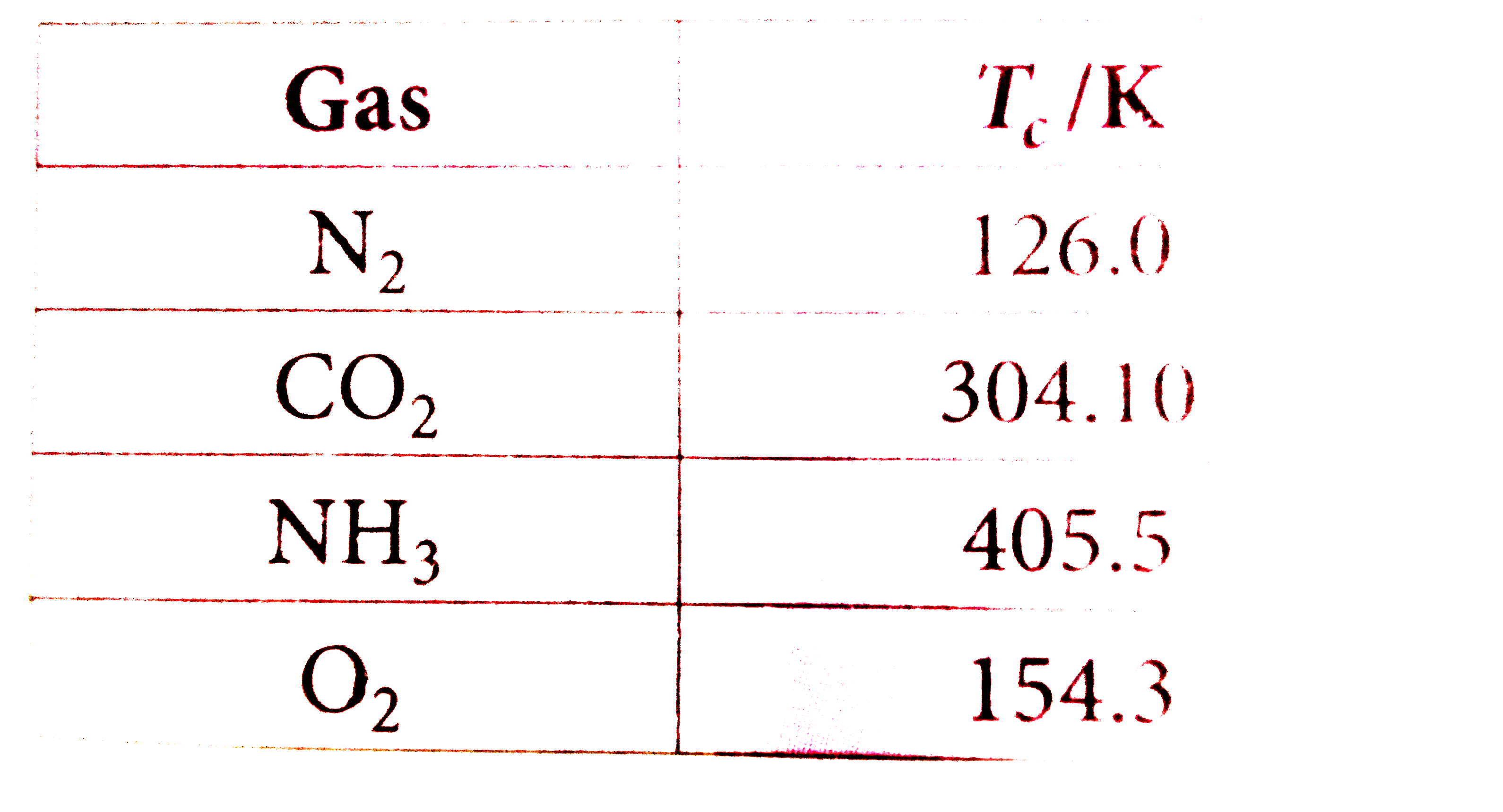Gases possess characteristic critical temperature which depends upon the magnitude of intermolecular forces between the gas particles. Critical temperatures of ammonia and carbon dioxide are 405.5 K and 304.10 K respectively. Which of these gases will liquify first when you start cooling from 500 K to their critical temperature ?
To determine which gas will liquefy first when cooling from 500 K to their respective critical temperatures, we can follow these steps:
1. Understand Critical Temperature: The critical temperature of a gas is the temperature above which it cannot be liquefied, regardless of the pressure applied. Below this temperature, the gas can be converted into a liquid.
2. Identify the Critical Temperatures:
- Ammonia (NH₃) has a critical temperature of 405.5 K.
- Carbon Dioxide (CO₂) has a critical temperature of 304.10 K.
3. Determine the Cooling Range: We are cooling from an initial temperature of 500 K down to the critical temperatures of both gases.
4. Calculate the Cooling Intervals:
- For Ammonia:
- Cooling from 500 K to 405.5 K involves a temperature change of:
500K−405.5K=94.5K
- For Carbon Dioxide:
- Cooling from 500 K to 304.10 K involves a temperature change of:
500K−304.10K=195.9K
5. Compare the Cooling Intervals:
- Ammonia requires a cooling of 94.5 K to reach its critical temperature.
- Carbon Dioxide requires a cooling of 195.9 K to reach its critical temperature.
6. Conclusion: Since ammonia reaches its critical temperature first (after cooling 94.5 K), it will liquefy first when cooling from 500 K. Therefore, ammonia will liquefy before carbon dioxide.
Final Answer:
Ammonia will liquefy first when cooling from 500 K to their critical temperatures.
---
- Ammonia (NH₃) has a critical temperature of 405.5 K.
- Carbon Dioxide (CO₂) has a critical temperature of 304.10 K.
- For Ammonia:
- Cooling from 500 K to 405.5 K involves a temperature change of:
500K−405.5K=94.5K
- For Carbon Dioxide:
- Cooling from 500 K to 304.10 K involves a temperature change of:
500K−304.10K=195.9K
- Ammonia requires a cooling of 94.5 K to reach its critical temperature.
- Carbon Dioxide requires a cooling of 195.9 K to reach its critical temperature.
Ammonia will liquefy first when cooling from 500 K to their critical temperatures.
Topper's Solved these Questions
- STATES OF MATTER BOOK - NCERT ENGLISHCHAPTER - STATES OF MATTER EXERCISE - EXERCISE
23 Videos
- SOME BASIC CONCEPTS OF CHEMISTRY BOOK - NCERT ENGLISHCHAPTER - SOME BASIC CONCEPTS OF CHEMISTRY EXERCISE - All Questions
45 Videos
- STRUCTURE OF ATOM BOOK - NCERT ENGLISHCHAPTER - STRUCTURE OF ATOM EXERCISE - EXERCISE
67 Videos
Similar Questions
Gases possess characteristic critical temperature which depends upon the magnitude of intermolecualr forces between the gas particles, critical temperatures of ammonia and carbon dioxide are 405.5 K and 304.10 K respectively. Which of these gases will liquefy first when you start cooling from 500 K to their critical temperature ?
View SolutionCritical temperature for carbon dioxide and methane are 31.1∘C and −81.9∘C respectively. Which of these has stronger intermolecular forces and why?
View Solution
Knowledge Check
Assertion :- On cooling ,ammonia lirquifies first whereas CO2 requires more cooling.
Reason :- Critical temperatures of ammonia and carbon dioxide are 405.5 K and 304.10 K respectively.AIf both assertion and reason are true and reason is the correct explanation of assertion .BIf both assertion and reason are true but reason is not the correct explanation of assertion .CIf assertion is true but reason is false .DIf both assertion and reason are false .
The critical temperatures of carbon dioxide and methane are 31.1∘C and −81.9∘C, respectively. Which of them has stronger intermolecular forces and why?
View SolutionGases posses characteristic critical temperature which depends upon the magnitude of intermolecular forces between the particles. Following are the critical temperatures of some gases.
GasesH2HeO2N2Critical temperature in kelvin33.25.3154.3126
From the above data what would be the order of liquefaction of these gases ? Start writing the order from the gas liquefying first
View SolutionCritical temperatuer of oxygen and nitrogen gas is 154.3 K and 126.0 K respectively. Which of these gases has higher magnitude of intermolecular forces between them ?
View SolutionCritical temperatures for A, B, C and D gases are 25∘C,10∘C,−80∘C and 15∘C respectively. Which gas will be liquefied more easily ?
View SolutionGiven below are the critical temperatures of a few gases . When the gases are started cooling , which gas will liquefy first and which will liquefy in the end ?

View SolutionAssertion: A gas with higher critical temperature gets adsorbed to more extent than a gas with lower critical temperature.
Reason: The easily liquefiable gases get adsorbed to more extent which have higher critical temperature.
View SolutionThe rate at which a substance cools in moving air is proportional to the difference between the temperatures of the substance and that of the air. If the temperature of the air is 290 K and the substance cools from 370 K to 330 K in 10 min, when will the temperature be 295 K?
View Solution
